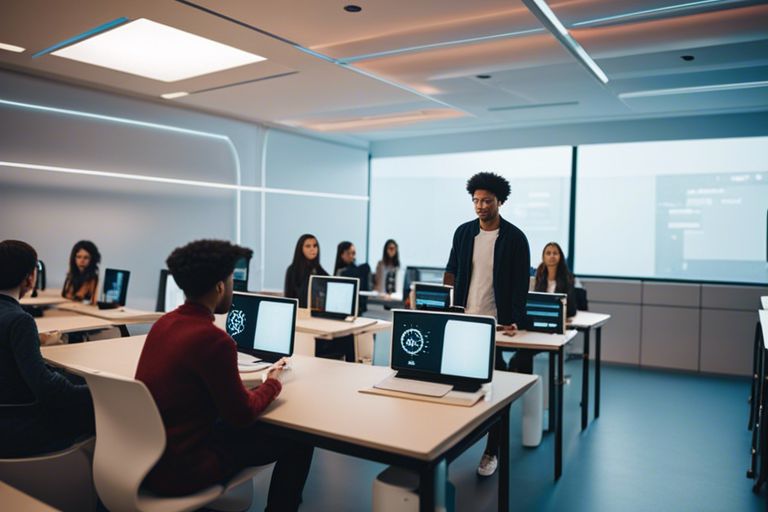Chatbots have revolutionized the way educational institutions interact with students, boosting engagement and enriching learning experiences. In this comprehensive guide, we will examine into the powerful advantages of AI chatbots in the education sector, from providing instant support and personalized assistance to increasing retention rates and improving student satisfaction. Learn how implementing AI chatbots can transform the student experience and propel your institution into the future.
Understanding AI Chatbots
Definition and Evolution of AI Chatbots
Even before the advent of artificial intelligence, chatbots were designed to simulate conversation with human users over the internet. However, with the advancement of AI technology, chatbots have become more sophisticated in understanding and responding to user queries in a more human-like way.
AI Chatbots are computer programs that use artificial intelligence to simulate conversation with users. They are designed to understand natural language and provide relevant responses to user queries. The evolution of AI chatbots has led to more personalized and engaging interactions with users, making them valuable tools in various industries, including education.
How AI Chatbots Work
Assuming the role of a virtual assistant, AI chatbots analyze user input using natural language processing techniques to comprehend the user’s intent and context. Based on this understanding, the chatbot formulates a response or takes appropriate action to assist the user.
For instance, in education, AI chatbots can enhance student engagement by providing instant answers to questions, personalized learning recommendations, and timely feedback on assignments. This not only improves the learning experience but also streamlines administrative tasks for teachers and academic institutions.
Types of AI Chatbots for Education
If you are interested in implementing AI chatbots in an educational setting, it’s imperative to understand the different types available. From rule-based chatbots to machine learning and hybrid models, each type offers unique capabilities to enhance student engagement and learning outcomes. Let’s explore the various types of AI chatbots for education:
Rule-Based Chatbots
If you are looking for a chatbot that follows a set of predefined rules to respond to user queries, rule-based chatbots are the way to go. These chatbots are programmed with specific decision trees and patterns to provide responses based on keywords or phrases. While they may lack the ability to learn from interactions, rule-based chatbots are excellent for handling frequently asked questions and providing instant answers to students. The simplicity and predictability of these chatbots make them ideal for straightforward tasks and basic information dissemination.
Machine Learning Chatbots
Even if you are looking for a more advanced chatbot that can learn and improve over time, machine learning chatbots are the perfect choice. These chatbots leverage algorithms to analyze data, understand user intent, and continuously enhance their responses based on past interactions. The ability to adapt and evolve makes machine learning chatbots highly effective in providing personalized assistance, recommendations, and feedback to students.
Types of machine learning chatbots include natural language processing (NLP) models that can understand and generate human-like responses. By incorporating NLP capabilities, these chatbots can engage in more meaningful conversations and provide tailored support to students.
Hybrid Chatbots
If you want to combine the best of both rule-based and machine learning approaches, hybrid chatbots offer a versatile solution for educational institutions. By integrating predefined rules with machine learning algorithms, these chatbots can handle basic queries efficiently while also learning from user interactions to improve responses over time. If you are looking for a chatbot that can provide both instant answers and adaptive learning capabilities, a hybrid model could be the ideal choice.
Hybrid chatbots can leverage rule-based mechanisms for common queries and employ machine learning algorithms to handle more complex questions or situations. This combination ensures an enhanced user experience and enables chatbots to offer personalized support to students at scale.
Factors to Consider When Implementing AI Chatbots
After deciding to implement an AI chatbot in your educational institution, there are several factors to consider to ensure its successful integration. These factors include technical requirements, pedagogical alignment, and student needs and preferences.
Technical Requirements
To successfully implement an AI chatbot for student engagement, it is important to consider the technical requirements. This includes ensuring that the chatbot platform is compatible with existing systems, has a user-friendly interface, and can handle the expected volume of interactions. Additionally, it is crucial to have a plan in place for maintenance, updates, and troubleshooting to ensure the chatbot operates smoothly.
Pedagogical Alignment
While integrating an AI chatbot in educational settings, it is important to align its function with pedagogical goals. This involves designing the chatbot to support teaching and learning objectives, provide timely feedback to students, and enhance overall engagement. The chatbot should complement the existing curriculum and offer resources that cater to diverse learning styles and preferences.
The pedagogical alignment of an AI chatbot can significantly impact its effectiveness in boosting student engagement and academic performance. By aligning the chatbot with educational goals, instructors can leverage its capabilities to create a more interactive and personalized learning experience for students.
Student Needs and Preferences
Student engagement is heavily influenced by their needs and preferences, making it crucial to consider these factors when implementing an AI chatbot. Understanding what students require in terms of support, feedback, and resources can help tailor the chatbot’s functionality to better meet their needs. Additionally, considering students’ preferences for communication channels and interaction styles can enhance the chatbot’s effectiveness.
Student feedback and data analysis play a key role in fine-tuning the AI chatbot to better serve students’ needs and preferences. By continuously gathering and analyzing feedback, educational institutions can ensure that the chatbot remains relevant and useful for students throughout their academic journey.
For instance, incorporating features like personalized recommendations, adaptive learning pathways, and interactive quiz sessions can significantly enhance student engagement and motivation to participate in online learning activities.
Pros of Using AI Chatbots in Education
Personalized Learning Experiences
All educational institutions strive to provide personalized learning experiences to their students. With AI chatbots, this goal becomes achievable on a large scale. These chatbots can interact with students in real-time, understand their learning styles, preferences, and pace, and tailor educational content accordingly. This level of personalization can significantly enhance the learning experience and boost student performance.
Increased Student Engagement
AI chatbots in education can significantly increase student engagement by providing instant support and assistance whenever students need it. Chatbots are available 24/7, allowing students to ask questions, seek clarification on concepts, or receive guidance on assignments at any time. This accessibility creates a more interactive learning environment, keeping students engaged and motivated throughout their educational journey.
For educators, increased student engagement can lead to higher retention rates and improved academic success.
Efficient Feedback and Assessment
To enhance the learning process, timely feedback and assessments are crucial. AI chatbots can streamline this process by providing immediate feedback on quizzes, assignments, and projects. They can also assist educators in grading assessments more efficiently, saving time and enabling instructors to focus on teaching. This efficient feedback loop helps students track their progress, identify areas for improvement, and ultimately enhance their learning outcomes.
Some AI chatbots are equipped with machine learning algorithms that can analyze student responses and provide adaptive feedback, further personalizing the learning experience.

Cons of Using AI Chatbots in Education
Limited Contextual Understanding
Despite the advancements in artificial intelligence, AI chatbots still have limitations when it comes to contextual understanding. Little nuances in language, tone, or cultural references can sometimes confuse AI chatbots, leading to inaccurate responses or misunderstandings. This can be especially problematic in educational settings where clear communication is crucial for student learning.
Dependence on Data Quality
Even though AI chatbots rely on vast amounts of data to function effectively, their performance is heavily reliant on the quality of this data. Even small inaccuracies or biases in the data can result in misleading answers or recommendations. Educational institutions must ensure that the data used to train AI chatbots is diverse, accurate, and regularly updated to avoid potential issues.
Data integrity is necessary for the successful implementation of AI chatbots in education. Without reliable data sources, AI chatbots may provide students with incorrect information or guidance, ultimately hindering their learning experience. Educational institutions must invest time and resources into maintaining high-quality data to maximize the benefits of AI chatbots.
Potential Job Displacement
Even though AI chatbots can streamline certain tasks and processes in education, there is a concern about the potential displacement of human jobs. Even though AI chatbots are designed to assist and enhance the work of educators, there is a possibility that they could replace some roles, leading to job loss within the education sector.
This issue raises important ethical and social considerations that need to be carefully addressed by educational institutions. While AI chatbots can bring efficiency and innovation to education, it is necessary to strike a balance between technological advancement and human employment to ensure a sustainable future for all stakeholders involved.
Tips for Effective AI Chatbot Implementation
Once again, successful implementation of an AI chatbot in an educational setting requires careful planning and execution. Here are some key tips to consider:
Define Clear Goals and Objectives
To ensure the effectiveness of your AI chatbot, it is crucial to define clear goals and objectives for its implementation. Clearly outline what you want the chatbot to achieve, whether it’s improving student engagement, providing quick answers to common questions, or offering personalized support. By setting specific goals, you can measure the success of the chatbot and make necessary adjustments to enhance its performance.
Choose the Right Chatbot Platform
Right from the start, it is crucial to choose the right chatbot platform that aligns with your educational institution’s needs and capabilities. Consider factors such as ease of customization, integration with existing systems, scalability, and security features. With the right platform, you can streamline the implementation process and ensure a seamless user experience for both students and staff.
With the plethora of chatbot platforms available in the market, it is important to conduct thorough research and comparisons to select the one that best suits your requirements. Look for features like natural language processing, machine learning capabilities, analytics tools, and support for multi-channel communication. Additionally, consider the vendor’s reputation, customer reviews, and pricing models before making a decision.
Monitor and Evaluate Performance
Chatbot performance should be regularly monitored and evaluated to identify areas for improvement and ensure optimal functionality. Track key metrics such as response times, user satisfaction rates, query resolution accuracy, and conversation flow. By analyzing this data, you can refine the chatbot’s responses, update its knowledge base, and enhance its overall performance over time.
After implementing an AI chatbot in your educational institution, continuously gather feedback from students, faculty, and staff to gauge their satisfaction levels and address any issues that may arise. Use surveys, focus groups, and performance analytics to gather insights and make data-driven improvements to the chatbot’s capabilities.
Step-by-Step Guide to Building an AI Chatbot
Identifying the Target Audience
| Target Audience | Details |
| Students | Understand the needs, preferences, and challenges of students to tailor the chatbot’s responses effectively. |
| Faculty Members | Consider what information faculty members may require assistance with, such as grading policies or scheduling. |
Designing the Conversation Flow
Audience: When designing the conversation flow for your AI chatbot, it is crucial to map out the various scenarios and user interactions to ensure a seamless experience. Tailor the responses to be engaging and informative based on the specific needs of the target audience.
This: Focus on creating a natural conversational flow that mimics human interaction. Use branching logic to anticipate user responses and provide relevant replies. Incorporate multimedia elements like images, videos, and links to enhance the chatbot experience and engagement.
Integrating with Existing Systems
| Some | Details |
| CRM Systems | Integrate the chatbot with Customer Relationship Management systems to access student data and provide personalized responses. |
| Learning Management Systems | Connect the chatbot with Learning Management Systems to assist with course enrollment, assignment submissions, and other academic tasks. |
Guide: Ensure seamless integration with existing systems to streamline processes and provide a unified experience for users. Regularly update and maintain these integrations to leverage the full potential of the AI chatbot.
AI Chatbots for Student Support
Virtual Learning Assistants
Student academic support is crucial for their success in the education journey. AI chatbots can act as virtual learning assistants, providing instant help to students with their queries related to coursework, assignments, or projects. These chatbots can offer 24/7 support, helping students navigate complex subjects and providing resources for further learning.
Mental Health and Wellness Support
With the rise in mental health issues among students, AI chatbots are playing a crucial role in providing mental health and wellness support. These chatbots can offer a safe space for students to express their feelings and seek guidance. They can provide resources for stress management, coping techniques, and even escalate serious concerns to human counselors for intervention.
For instance, a student may confide in a mental health chatbot about feeling overwhelmed with academic pressure. The chatbot can offer relaxation techniques, suggest counseling services on campus, or even schedule a virtual therapy session with a licensed professional.
Career Guidance and Mentorship
Mental and emotional support are not the only areas where AI chatbots excel. They can also provide valuable career guidance and mentorship to help students prepare for their future. Chatbots can assist students in exploring different career paths, finding internships, and connecting with industry professionals for mentorship opportunities.
It is necessary for students to have access to comprehensive support services, and AI chatbots are revolutionizing the way students engage with academic institutions by providing personalized assistance in various aspects of their student journey. Whether it’s academic help, mental health support, or career guidance, AI chatbots are enhancing student support services to boost overall engagement and success.
AI Chatbots for Teaching and Learning
Keep up with the evolving landscape of education by utilizing AI chatbots for teaching and learning. These advanced technologies have the potential to revolutionize the way students engage with course materials and interact with instructors.
Adaptive Assessments and Quizzes
Learning can be tailored to each student’s individual needs through adaptive assessments and quizzes powered by AI chatbots. These chatbots can analyze student responses in real-time and provide instant feedback, helping students identify areas where they need improvement. By personalizing assessments, educators can ensure that each student receives targeted support to enhance their learning outcomes.
Intelligent Tutoring Systems
Some of the most innovative applications of AI chatbots in education are intelligent tutoring systems. These systems utilize machine learning algorithms to adapt to each student’s learning style and pace. By simulating one-on-one interactions with a human tutor, AI chatbots can provide personalized guidance and explanations to help students master complex concepts.
Virtual Field Trips and Simulations
Tutoring can be taken to the next level with AI chatbots that offer virtual field trips and simulations. These interactive experiences allow students to explore new environments and engage with course material in a hands-on way. By immersing students in realistic scenarios, AI chatbots can enhance comprehension and retention of key concepts.
If you’re looking to elevate the student learning experience, incorporating virtual field trips and simulations through AI chatbots is a powerful way to capture students’ interest and enhance their understanding of complex subjects.
AI Chatbots for Administrative Tasks
Automating Routine Inquiries
For educational institutions, handling routine inquiries can be time-consuming and repetitive. AI chatbots can assist in automating these inquiries, providing students with quick and accurate responses to common questions about campus facilities, academic programs, important dates, and more. By implementing AI chatbots for administrative tasks, institutions can free up staff members to focus on more complex and personalized student interactions.
Streamlining Admissions and Enrollment
For educational institutions, the admissions and enrollment process can be a complex and lengthy procedure. AI chatbots can streamline this process by providing timely and detailed information to prospective students about application requirements, deadlines, and program details. By offering personalized assistance and guidance, AI chatbots can help increase enrollment numbers and improve the overall experience for applicants.
Routine: AI chatbots can handle routine inquiries related to admissions and enrollment, such as providing information on application submission procedures, required documents, and admission criteria. By automating these tasks, institutions can reduce wait times and improve efficiency in processing applications.
Enhancing Campus Safety and Security
Enhancing campus safety and security is a top priority for educational institutions. AI chatbots can play a crucial role in this area by providing students with real-time information on emergency procedures, campus safety tips, and reporting mechanisms for suspicious activities. By leveraging AI technology, institutions can strengthen their security measures and create a safe learning environment for all members of the campus community.
Security: AI chatbots can quickly disseminate important security alerts and updates to students and staff in case of emergencies, such as natural disasters or campus threats. By enabling instant communication and response capabilities, AI chatbots can help ensure a swift and coordinated reaction to any safety concerns on campus.
Overcoming Common Challenges
Addressing Technical Issues
Not every AI chatbot implementation goes without a hitch. Technical issues can arise, such as integration problems with existing systems or bugs in the chatbot’s programming. It’s crucial to address these issues promptly to ensure a seamless user experience for students.
Managing Student Expectations
Managing student expectations is crucial when implementing an AI chatbot in an educational setting. Students may have unrealistic expectations of the chatbot’s capabilities and may become frustrated if the chatbot cannot meet all their needs.
For instance, it’s important to clearly communicate the chatbot’s purpose and limitations to students from the outset. Setting realistic expectations and providing guidance on how to best utilize the chatbot can help manage student expectations effectively.
Ensuring Data Privacy and Security
The use of AI chatbots in education raises concerns about data privacy and security. As chatbots collect and store student data, it is imperative to prioritize data privacy and security measures to protect sensitive information from unauthorized access or breaches.
The implementation of encryption protocols, regular security audits, and compliance with data protection regulations are crucial steps in ensuring data privacy and security when using AI chatbots in educational settings.
Future of AI Chatbots in Education
Many educators and developers are excited about the potential of AI chatbots to revolutionize the way students engage with learning materials. As technology continues to advance, we can expect to see even more innovative applications of AI chatbots in education. From personalized learning experiences to real-time feedback and support, the possibilities are endless.
Emerging Trends and Technologies
Little advancements such as natural language processing and machine learning algorithms are making AI chatbots more sophisticated and capable of providing intelligent responses to students. In the future, we may see chatbots that can adapt to individual learning styles, track progress, and even anticipate students’ needs before they arise.
Potential Impact on Education Policy
An important potential impact of AI chatbots in education is the way they could influence policy decisions. As data on student interactions with chatbots is collected and analyzed, policymakers may use this information to inform curriculum development, resource allocation, and even standardized testing procedures.
Implications for Teacher Training and Development
A key implication of AI chatbots in education is the need for teachers to adapt to this new technology and incorporate it into their practice. While some may fear that chatbots will replace teachers, the reality is that they can actually enhance the teacher’s role by providing valuable insights into student progress and individualized support.
Technologies
Technologies such as AI chatbots can offer teachers a new way to engage with their students and provide more personalized support. By leveraging chatbots, teachers can free up time for more one-on-one interactions with students, focusing on higher-order thinking skills and emotional support.
Plus, the use of AI chatbots in teacher training programs can help educators learn how to effectively integrate this technology into their classrooms, ultimately improving student outcomes and creating a more engaging learning environment.
Best Practices for AI Chatbot Development
Human-Centered Design Principles
Your AI chatbot development should start with human-centered design principles. Practices such as understanding user needs, involving students in the design process, and prioritizing user experience are crucial for creating a successful chatbot that truly engages students. By focusing on the end-users and their requirements, you can ensure that the chatbot meets their needs effectively.
Inclusive and Accessible Design
Human-centered design extends to making your AI chatbot inclusive and accessible to a diverse range of students. This means considering factors such as different learning styles, language preferences, and accessibility needs. By designing with inclusivity in mind, you can ensure that all students, regardless of their background or abilities, can benefit from interacting with the chatbot.
This approach involves creating features such as text-to-speech functionality for visually impaired students, language options for international students, and easy navigation for those with cognitive disabilities. By prioritizing inclusive design, you can make your chatbot a valuable tool for a wider range of students.
Continuous Testing and Iteration
Design an AI chatbot that undergoes continuous testing and iteration to improve its performance over time. Regularly gathering feedback from students and analyzing usage data can help you identify areas for improvement and refine the chatbot’s functionality. By iteratively testing and updating the chatbot, you can ensure that it remains relevant, efficient, and engaging for students.
Through ongoing testing and iteration, you can also address any technical issues or bugs that may arise, ensuring a seamless user experience. This commitment to continuous improvement will help you create a chatbot that evolves with the needs of your students and continues to deliver value in the long term.
To wrap up
Taking this into account, AI chatbots have proven to be a valuable tool for boosting student engagement in various educational settings. Their ability to provide instant responses, personalized feedback, and round-the-clock support can significantly enhance the learning experience for students. By leveraging the power of AI chatbots, educators can create a more interactive and dynamic learning environment that caters to the individual needs of each student.
As technology continues to advance, the role of AI chatbots in education is only expected to grow. With their potential to streamline administrative tasks, facilitate communication, and deliver targeted assistance, AI chatbots are poised to revolutionize the way students engage with course materials and interact with instructors. By embracing this technology, educational institutions can stay ahead of the curve and provide a more immersive and interactive learning experience for their students.
FAQ
Q: What is an AI Chatbot?
A: An AI chatbot is a computer program that uses artificial intelligence to conduct conversations with users via text or voice interactions.
Q: How can AI Chatbots boost student engagement?
A: AI chatbots can provide instant support to students, answer their queries promptly, offer personalized learning experiences, and enhance student-teacher communication.
Q: What are the benefits of using AI Chatbots in education?
A: Some benefits of using AI chatbots in education include improved student engagement, round-the-clock assistance, scalability, cost-effectiveness, and data-driven insights for educators.
Q: Are AI chatbots capable of replacing human teachers?
A: AI chatbots cannot replace human teachers but can complement their work by handling routine tasks, providing support, and offering personalized learning experiences to students.
Q: How can educators integrate AI chatbots into their teaching practices?
A: Educators can integrate AI chatbots into their teaching practices by using them for answering student queries, providing feedback on assignments, conducting quizzes, offering learning resources, and tracking student progress.
Q: Are there any privacy concerns associated with using AI chatbots in education?
A: Educators and institutions need to ensure that AI chatbots comply with data protection regulations, safeguard student information, and prioritize data security to address privacy concerns.
Q: How can students benefit from interacting with AI chatbots?
A: Students can benefit from interacting with AI chatbots by receiving immediate responses to their queries, accessing personalized learning materials, improving their problem-solving skills, and feeling supported throughout their educational journey.




